Google releases one or two changes to its algorithms daily; most of them are not noticeable.
And a few times a year, Google will officially announce a “core update.”
A core update refers to broad changes to Google’s algorithm and systems that cause notable fluctuations in search results.
This article is an up-to-date summary of the impact of the May 2022 core update on industries, search queries, and the search result page.
Winners and losers are analyzed to provide additional insights and links to help your website recover from the impact of these changes.
Core Update Terminology
No one knows the exact nature of core updates unless Google tells us, as it has in the past with the Speed update or Freshness update.
To analyze the impact a Google core update has on organic search results, we can look at two things: visibility and volatility.
Visibility tells us the organic presence of a domain in Google’s search results.
When the visibility metric increases, a site ranks for more high-volume keywords likely to attract clicks.
Conversely, a decreasing visibility metric means that the domain is losing keywords.
How much the visibility metric increases or decreases is known as “volatility.”
We can tell when core updates affect a website because the visibility metric drastically increases or decreases during a defined period that aligns with Google’s announcement.
With these two terms in mind, let’s view Semrush Sensor data and the Sistrix visibility index to see what we can learn about the May Core Update 2022.
Industries Affected
Marketers discussed huge swings and drops in traffic across sites early in the roll-out.
Semrush sensor data showed that the May 2022 update was mild compared to the last core update in November 2021.
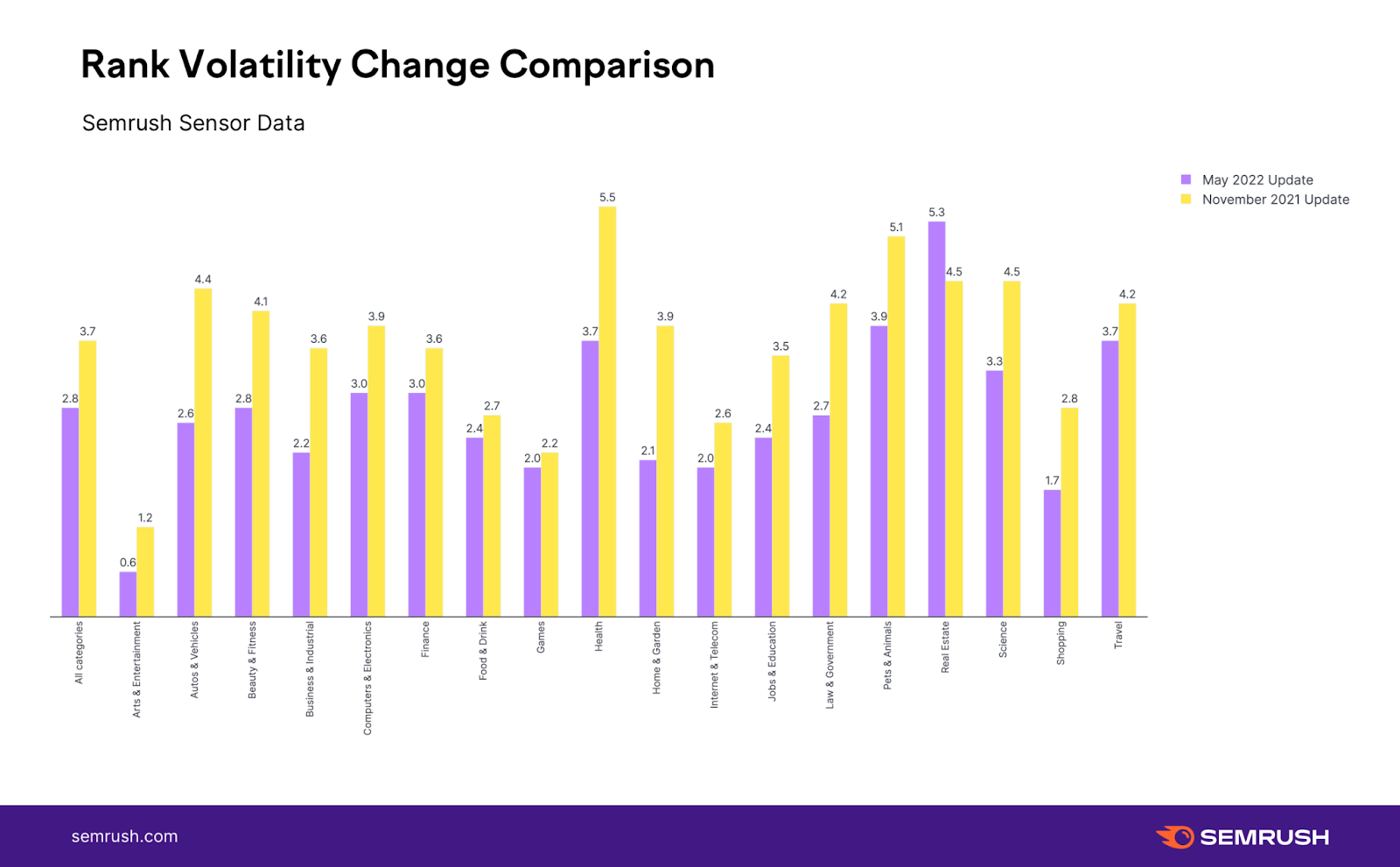 Screenshot from Semrush, June 2022.
Screenshot from Semrush, June 2022.Mordy Oberstein, Head of SEO branding at Wix, reviewed Semrush Sensor data on June 01 and did not find any indicators that the May 2022 update targeted specific industries.
I asked Oberstein what fluctuations would indicate that an update targeted a specific niche, and he replied that he doesn’t think Google targets particular verticals; that it’s not a hard number, but rather, a consistent trend across types of content within that vertical.
Oberstein recommends that people look at what is happening at the page level, “…because you wouldn’t really be able to diagnose what was happening until you looked at a specific (keyword) ranking shift.”
Search Queries Affected
During a Wix webinar, Marcus Tober, Founder of Searchmetrics, broke down rank volatility by keyword intent using Semrush sensor data.
Keyword intent can be split into four main categories:
- Informational: Find an answer to a question or general information.
- Navigational: Find a specific site or page.
- Commercial: Investigate brands or services.
- Transactional: Complete an action or purchase.
Here’s new @semrush data that @marcustober just shared during our @Wix webinar on rank volatility from the May 2022 Core Update…. per intent!
I’ve never seen rank volatility data broken down like this… very cool! pic.twitter.com/MW5YZPxUPC
— Mordy Oberstein 🇺🇦 (@MordyOberstein) June 28, 2022
The graph shows informational (an answer) and transactional (a purchase) search queries experiencing over 50% volatility during the May 2022 core update.
Tober’s findings align with who we saw win and lose in the SISTRIX visibility index, which we will dive into next.
Winners and Losers
We can see the following winners and losers based on the Sistrix visibility index (keyword rankings weighted by search volume and click probability).
Winners
Winners were defined as those among the top 20 websites by absolute visibility change in the UK.
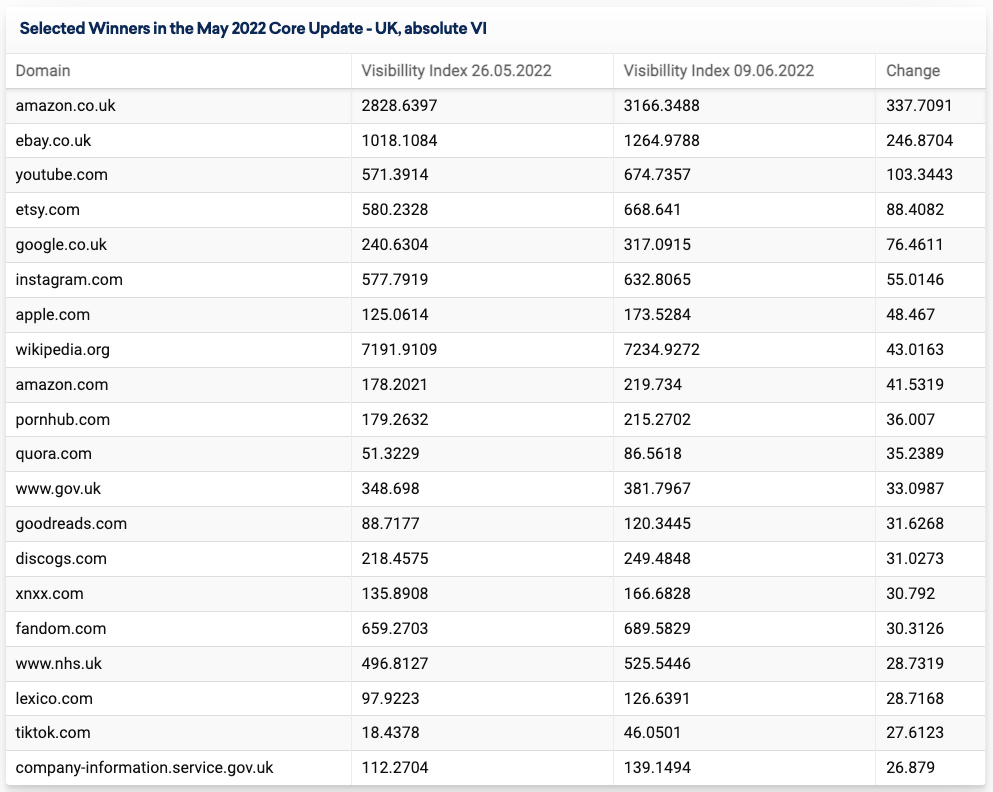 Screenshot from Sistrix, June 2022.
Screenshot from Sistrix, June 2022.Big Brand eCommerce
eCommerce has been a popular topic of conversation on social media, and the Sistrix UX visibility index supports this chatter.
Branded retail websites like Amazon, eBay, and Etsy are seen in the table above as having the greatest absolute visibility change.
They are taking up more of the hypothetical “storefront” online.
This expansion of brand presence and the three product review updates over the past year may explain the drop affiliate site owners are experiencing.
 Screenshot from Google SERP, June 2022.
Screenshot from Google SERP, June 2022.The big brand ecommerce websites winning (Amazon, eBay, and Etsy) are outpacing smaller sites in implementing full product schema.
This finding aligns with the 51% volatility in transactional (a purchase) search queries shared by Marcus Tober.
Video
Video sites like YouTube, TikTok, Disney Plus, Hulu, and Twitch increased significantly.
TikTok had the most impressive growth — red line seen below — with an overall gain of 133%.
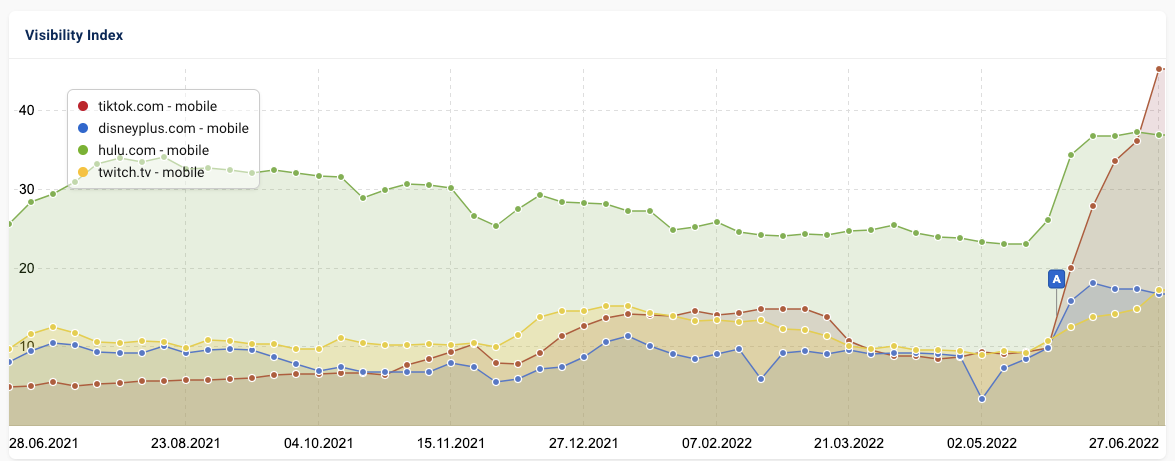 Screenshot from Sistrix, June 2022.
Screenshot from Sistrix, June 2022.This phenomenon plays into what we know about how the internet is evolving.
People like watching videos online, and Google is already indexing videos from millions of different sites.
They can find videos on the main search results page, video search results, Google Images, and Discover.
During an episode of the “Off The Record” podcast in March, Google Product Manager Danielle Marshak said, “We think this kind of content could be useful for a lot of different types of search queries, and we’ve been experimenting with how to show it to users more often.”
Losers
Losers were defined as groups that experienced a significant decrease in Sistrix’s visibility index.
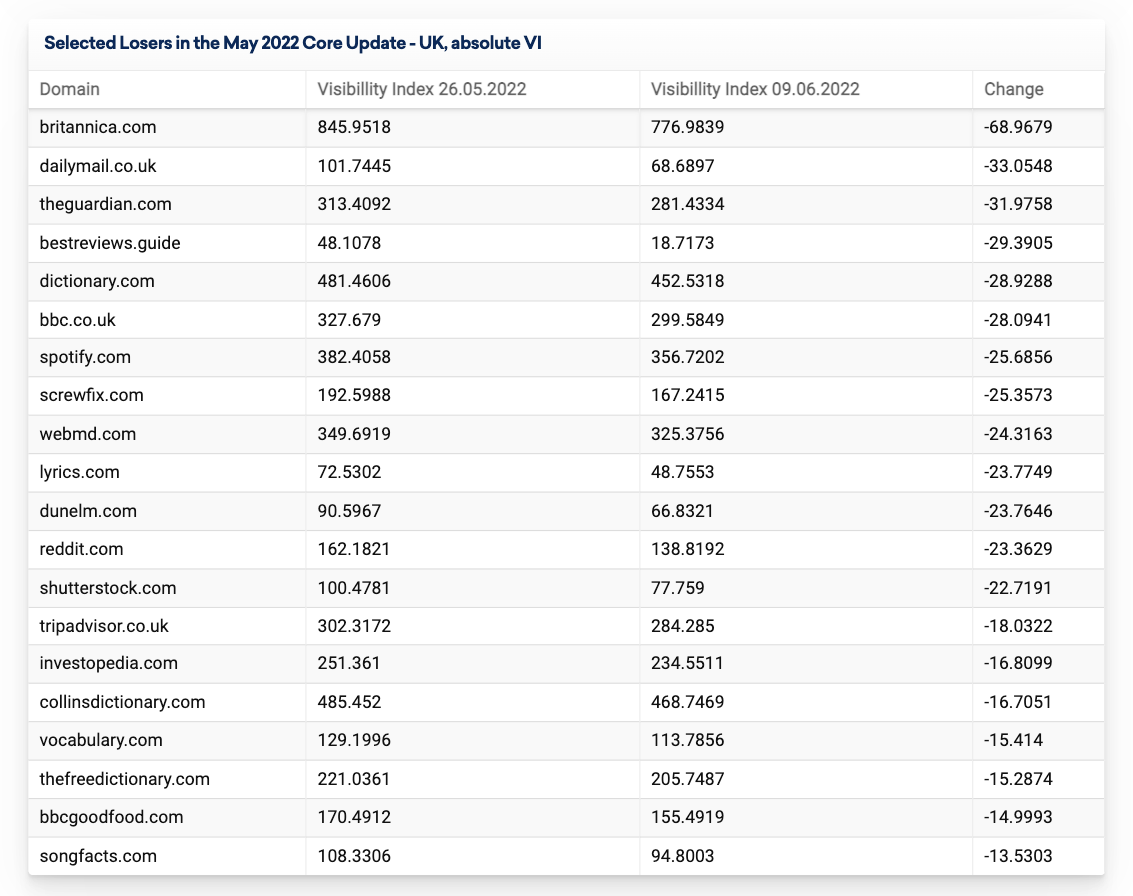 Screenshot from Sistrix, June 2022.
Screenshot from Sistrix, June 2022.News and Media Publishers
Among the 30 news websites analyzed, Steve Paine, the Marketing Manager at Sistrix, found a general loss for most news and media publishers.
The loss primarily affected generalists that write about everything; e.g., celebrity news, sports results, weather, economy, and career advice.
In the example provided below, you can see independent.co.uk getting quite the boost for its /topic directory, while competitor dailymail.co.uk (no topic landing pages) tanks.
 Screenshot from Sistrix, June 2022.
Screenshot from Sistrix, June 2022.While “Google knows that while you may have the latest news for the Knicks,” explained Malte Landwehr, former VP of Product at Searchmetrics, it “does not mean you are what people searching for [queries like] ‘eyeshadow’ … are looking for.”
Reference Websites
References websites – including dictionaries, Wikipedia-knockoffs, lyrics, and stock photo sites – were among the losers.
Landwehr explains that you can think of these pages (reference pages) as “backfill” to Google.
While a definition-type page may seem relevant based on TF-IDF, Word2Vec, or similar approaches, they rarely match the search intent.
This finding is supported by what Marcus Tober found with informational keywords experiencing 54% volatility.
New SERP Features
You may have noticed different rich results in the SERP for transactional queries in a visual grid format.
It looks like image thumbnails of a product, and when you click a product, a knowledge panel opens with shopping options.
The grid format was initially spotted on mobile around late March 2022 and now appears on desktop. You can test it yourself with product queries such as “sleep sack” or “paintbrush.”
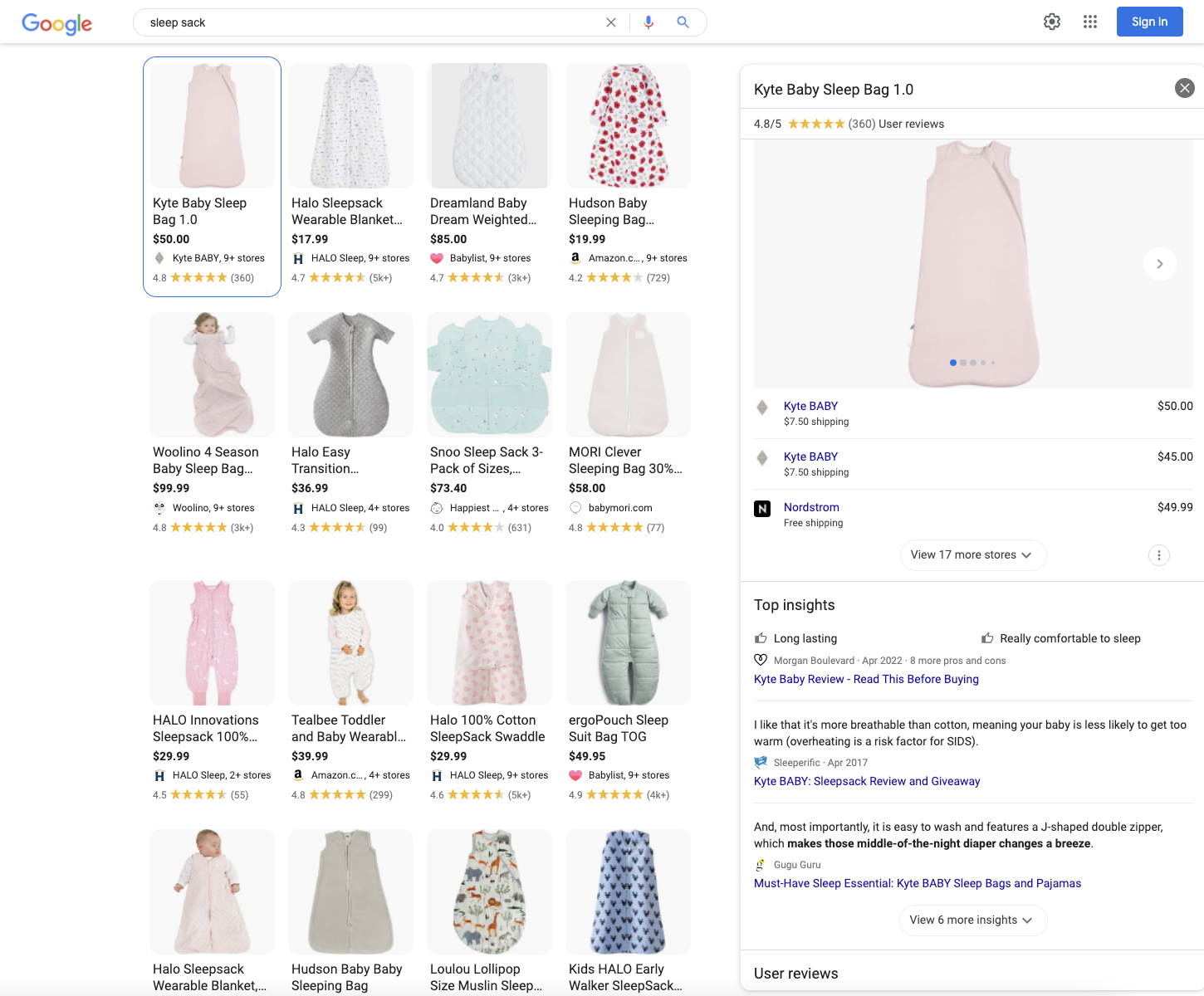 Screenshot from Google SERP, June 2022.
Screenshot from Google SERP, June 2022.While these new shopping features could be seen a few days before the official May 2022 update announcement, they are essential to mention, as they undoubtedly influence eCom traffic – and it’s easy to misattribute the effects of the core update.
Rise of the Visual SERP: What This Means For Marketers
Core updates are changes made to improve Google search results overall, and to help Google keep pace with the changing nature of how people search.
If you see a drop in your rankings, it’s an undeniable signal that you need to update your content to match the current search intent and keep up with updates in your industry.
Here’s a recap of what we see changing.
Video Search Results: The New SEO Frontier
Demand for video content is increasing. A recent study found that 73% of people preferred to watch a short video to learn about a product or service.
And Google knows it.
Videos already appear in several places on Google. And, remember Marshak’s earlier remarks: that Google is experimenting with how to show video content to users more often.
(Interested in learning how to help Google find and fetch your video content? Discover these 5 video SEO best practices.)
Visualize Product Information with Rich Snippets
In a study of the May core update, transactional (purchase) search queries showed a 51% volatility.
eCommerce website owners can enhance their search results by adding schema markup.
Doing so helps potential buyers by providing additional information such as prices or ratings.
For example, more people may click on a search result displaying a high review rating because it provides positive social proof.
You can visualize your own product information by adding structured data to your product pages.
Google Shopping Visual Grid Format
It’s no secret that shopping behavior has changed drastically in the past two years; e-commerce sales, for instance, increased by 43% in 2020.
Hundreds of millions of people are searching for transactional queries daily, and Google is testing new ways of getting products in front of the people searching for them.
Spotted a few days before the official Google May 2022 update announcement, we can see products in a visual grid that opens to the knowledge panel mentioned above.
If you’re interested in growing your business with these features, check out this episode of the SEJ Show with Duane Brown, SEJ contributor, on how to dominate Google Merchant center.
Final Thoughts
I do hope the May 2022 update coverage here is helpful. If your website was negatively impacted, I strongly recommend reading Google’s advice on how to assess your content after a core update.
Remember, what I wrote above is a hypothesis; an educated guess based on publicly available data.
Did your site visibility improve or decline with the May 2022 update? Let us know on Twitter, LinkedIn, or Facebook.
Featured Image: JaaaK/Shutterstock
